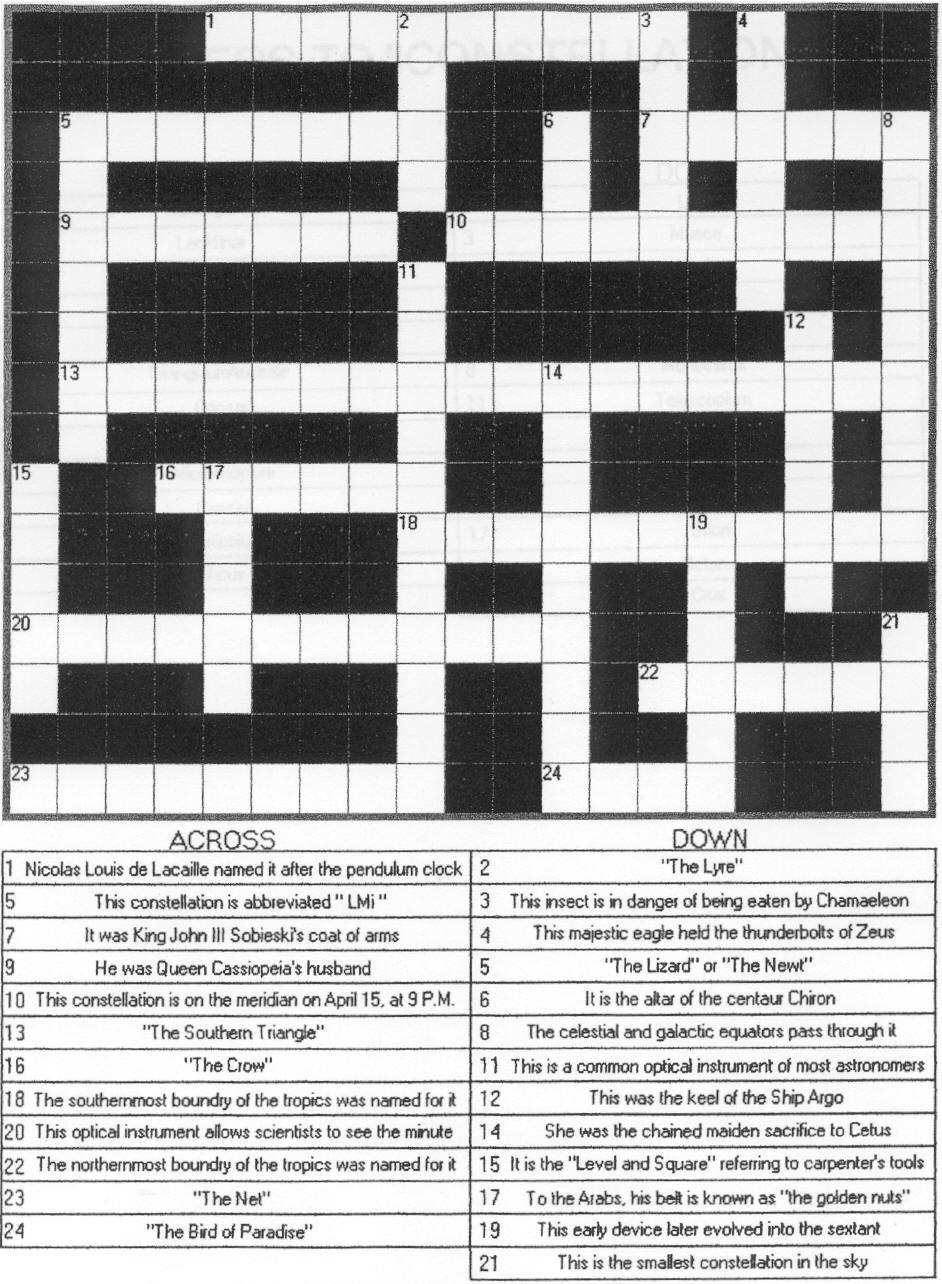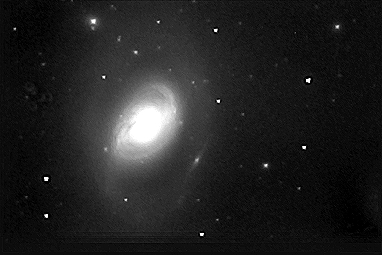

OAS Executive Committee:
President- Ron Vanderhule Ph. (801) 544-9458
Vice Pres- Dave Dunn Ph. (801) 544-7705
Secretary- Bob Tillotson Ph. (801) 773-8106
Treasurer- Doug Say (801) 731-7324
Vol. 29 Number 8 May 2000 http://physics.weber.edu/oas/oas.html
The May Meeting
The monthly meeting of the Ogden Astronomical Society will be held on Thursday May 11,
2000 at 7:30 p.m. in the Ott Planetarium on the Weber State University campus. The
meeting's subject had not been announced at the time of this printing. Details on upcoming
star parties will be among topics discussed.
*** *** ***
Antelope Island in May
The next scheduled public star party event is set for Saturday May 6 at Antelope Island State Park. Members may wish to arrive early in order to use their solar filters for viewing the sun. There have been reports of exceptionally interesting large sunspot groups on the solar disk. Using proper solar filters, these have even been reported to be naked-eye.
Introduce yourself at the gate as an OAS member in order to save the $7.00 entrance
fee. Set up in the east parking lot at White Rock Bay
*** *** ***
OAS Called For Private Star Party
Members of the club are needed to participate in a star party at Antelope Island on Friday night May 12, 2000. The Ogden based Ogden Surgical Medical Society will conclude their annual seminar by touring Antelope Island and stopping to view the universe, courtesy of The Ogden Astronomical Society. The OAS is collecting the customary fee for this activity so barring bad weather, members are requested to support this event by bringing their telescopes to the island for a relatively short star party.
The location on the island will be finalized at the May 11 meeting. For additional
information call Bob Tillotson.
*** *** ***
The President's Parsec
Greetings Earthlings:
I was showing some friends a few stellar objects a couple months ago, saving the best for last. When I turned the scope on Saturn the usual hallelujahs were uttered causing me to remark, " If Saturn were the only object in the sky it would be worth having a telescope". Then a minute later I said the same thing about M-42.
This gives me cause for reflection ( of course it does, I'm a Newtonian man ). Would we still invest our time and money if there were only one or two things of interest in the night sky?
Our public star parties would take on a different tenor for sure. People would wait silently in line for their turn to look at "it". "It seems like it's looking back ", said one small boy as he stepped away from the telescope. The people nearby mumbled their acknowledgment. Dr. Sohl's slide show is shorter but the interest is more intense. After a night of observing my wife would ask me in the morning, "is it still there?"
I guess my point is; how much stuff do we need floating outside our atmosphere to kindle an interest? I think we can be thankful for all that we have to train our scopes and attention on.
What if there was just the Sun, Earth, and that one object floating in the ocean of blackness? There would still be a sense of awe. The question "Where did it all come from?" would still frame the scientific and religious debates. The focus of our interest would be a lot more acute.
A French philosopher, whose name has receded from me at the moment, summed it up well when he said of the universe, "It's not so amazing that we have all of this, it's amazing that there is anything at all".
I think Ray Bradbury could do something with the concept in this column. Next stop the Twilight Zone
the Prez.
*** *** ***
Minutes
Ogden Astronomical Society
April 13, 2000
The monthly meeting of the Ogden Astronomical Society was called to order by club president Ron Vanderhule at 7:35 p.m.
Ron announced that WSU physics professor Dr. Bradley W. Carroll will be our speaker at the June meeting. The recent Antelope Island star party, the first of the season, was discussed. It proved to be very successful and the weather was perfect. Among the attendees were members of the Thiokol Astronomy Club. Ron told a joke... The Messier Marathon held in Penrose, Utah went well. Participating members described the event. An October Messier Marathon may be scheduled.
The evening's Show 'n Tell opened:
Ron described his eyepiece purchase at the February Swap Meet,
Doug Say recently visited Flagstaff, AZ and talked about visiting the Lowell Observatory and the Barringer Crater,
Steve Richer displayed and described some high quality astronomy reference books he has acquired,
Jim Seargeant described materials that can be used to darken the inner surfaces of telescope tubes,
Deloy Pierce discussed the various sites available to browse and purchase from the Internet,
Wayne Sumner demonstrated a Ronke Tester he created and he has industrial grade Teflon available for telescope mounts. Wayne is also seeking riders to share the trip to Riverside,
Dave Dunn recently purchased Lunar property and told how we all can buy a part of the moon,
Mark Durrwacher displayed an all aluminum 13 inch mirror he plans to mount in a telescope,
Bob Tillotson displayed a "T" shirt commemorating the comet Shoemaker Levi 9 crash on Jupiter. The shirt is autographed by the atrest, David Levi and Carolyn and Gene Shoemaker,
The meeting adjourned to conversations at 9:10 p.m.
Bob Tillotson, Secretary
Crossword Challenge
by Jeremy Mathews
"Constellations"

Solutions to this puzzle will be printed in next month's Star
Diagonal.
Jim Seargeant's - Images

M96
This image was taken on 10 March 2000 with the 12" Meade LX-200 operating at f/6.3 and the SBIG ST-7 running in the medium resolution mode (binned 2x2). I took 9 shots at 420 seconds each; one of them showed a bit too much elongation in the stars and was discarded, yielding 8 good exposures.
Each of the images was calibrated separately. By using Mira's batch function, bias,
dark, and flats can be applied to the entire set of images very quickly. Then I tried to
process the image so that it looked like something other than a fuzzy blob and things did
not go so well. First I median combined all 8 images to improve the signal to noise ratio.
Median combine calculates the median of pixel values in the individual images to avoid
letting a pixel far from the mean skewing the final result. Median combining eight good
images should give a very smooth, blemish free final image. I got a very smooth, blemish
free fuzzy blob. Next I tried maximum entropy deconvolution on the combined image, which,
according to Mira, " is a form of image restoration that uses information inherent in
the signal to enhance the image resolution. Unlike a simple sharpening filter, maximum
entropy increases the image resolution without enhancing the background noise." I had
seen good results from it before, but this time the blob was only slightly less fuzzy.
Hmm, perhaps there is not enough signal in the spiral arms of M96; they're just too faint.
I median combined the first four and then the last four images and then summed the two
results. This sacrifices some signal to noise ratio but increased the intensity of the
faint regions. It increased the intensity levels of the whole image, but the spiral arms
did seem a bot more distinct. Still a fuzzy blob, though. If a little is good, then more
..... So I median combined the eight images in four sets of two each, then summed the four
results. A little digital development processing, careful adjustment of brightness and
contrast, and I could start to see a bit of detail in the arms. Still very little more
than a fuzzy blob. This was getting a little frustrating (late, too). Why can't I do more
with what should be good images? I looked to various web pages for inspiration; what were
other people getting from M96? Fuzzy blobs. Ah! I was trying to make something out of not
much! Well, anyway, here is the result. In my web search I did see again the value of
color; the color images showed quite a bit more of interest in M96. Where the gradations
from one region to another are too subtle to show up in grayscale, the difference in color
were much more apparent. If I can get my color wheel running, I'll give M96 another try.
The image in the on-line newsletter should show up quite a bit better than this printed
version.
The University of Arizona's Students for the Exploration and Development of Space (SEDS)
at http://www.seds.org gives the following information on M96:
"M96 is the brightest member of the Leo I group of galaxies, which is therefore also
called the M96 group. Its distance was determined to be about 41 million light years
(after corrections for the distance scale which are implied by the results of ESA's
Hipparcos satellite) by Nial R. Tanvir with the Hubble Space Telescope by observing
Cepheid variables. Interpolated with the HST result of 35.5 million light years for its
neighbor M95, we adopt a value of 38 million light years here for the whole group.
At this distance, the apparent diameter of its brighter central region, 6 arc minutes, corresponds to a linear dimension of 66,000 light years. However, as can be seen e.g. in the Digital Sky Survey image, or the Hubble Atlas of Galaxies, this galaxy has faint extensions, an outer ring of filaments (spiral arm fragments), which are connected to the bright visible part near the northwest end of the major axis. This ring has a diameter of at least about 9 arc minutes in the DSS image, corresponding to about 100,000 light years.
The apparent visual brightness of 9.2 magnitudes corresponds to an absolute magnitude
of -21.1.
According to J.D. Wray's Color Atlas of Galaxies, the bright inner disk is
composed of a smooth yellow stellar population of old stars, which ends slightly beyond a
ring of blue knots. These knots are probably clusters of young, hot stars. As visible in
our image, this galaxy contains a significant amount of dust, which is apparently more
concentrated on the left side in our image. It is common that dust appears with greater
contrast on the near side of a galaxy than on the far side, so this asymmetry indicates
that the near side of M96 is on the left in our image.
G. de Vaucouleurs has determined that M96 is inclined by 35 degrees to our line of sight, and that it rotates with the spiral arms trailing.
A bright supernova, SN 1998bu, was discovered by Mirko Villi on May 9, 1998 at 13th magnitude and was quickly brightening to 11.8 mag."
Jim Seargeant